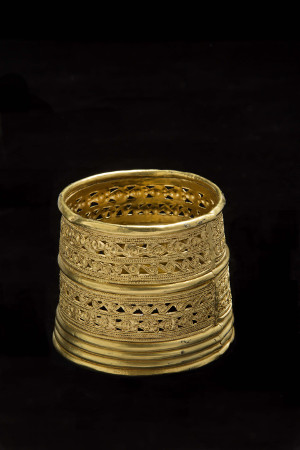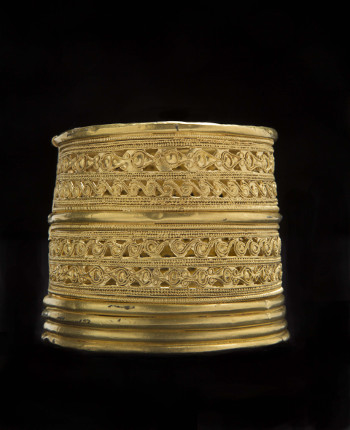
Item description
- Object: A pair of openwork and filigree gold ‘cuff’ armlets
- Date: ca 3rd – 1st centruy BC
- Dimensions: length 7 cm; diameter 8.3 tapering to 7.4 cm
Each armlet consists of a slightly tapering tube of two openwork and filigree sections banded by gold tubes. The openwork bands are in sheet gold to which the filigree motifs are attached. The latter are in the form of simple scrolls, perhaps stylised bird heads, and what appear to be intended as fish. It can be noted that if the upper pierced and filigree band on either armlet was inverted, the two armlets would form a perfect mirror-image pair, and so it is perhaps likely that the goldsmith made an error in his assembly of the parts. Ancient armlets, bracelets and earrings, all typically made as pairs in antiquity, were usually made as mirror images of each other.
The armlet was constructed in sections, each made flat and then bent into a circle and soldered together, as can be seen in the view of the interior of the armlet. The tubes and openwork parts are in hammered sheet gold and the plan wires are made in the so-called strip-twist technique. To make wire of this type a narrow strip of gold sheet is twisted and rolled between to flat surfaces. This rolling compacts the coiled strip into a circular section wire that typically retains the spirally seams. More extensive rolling, distortion of soldering in later working, or subsequent wear, can render these tell-tale spiralling seams far less apparent. Wires made the strip-twist wire method first appear in the ancient Near East by about 2000 BC and continued to be produced until succeeded by wire drawing by the 10th century AD in the West, seemingly slightly earlier in the Far East.
The beaded wires are of the spiral beaded type. This resembles a screw-thread and was made by rolling a round wire under an edge held at a slight angle. This type of wire first appeared in about the 7th century BC, and was rare after about the 1st century AD. Its use is best known in Etruscan and Hellenistic Greek work, and in in neighbouring lands. What is noteworthy here is that each separate motif is made from a single, continuous length of beaded wire – as can be seen in the photo right. The wire is bent back on itself to create the circular ‘eye’ of the fish. The technique and assembly of the armlet examined are as would be expected for its given date.
The results of the gold analysis were as follows (an average of 3):
| Gold | Silver | Copper |
|---|---|---|
| 82.23% | 15.26% | 3.17% |
No other elements were detected with certainty at levels resolvable by the equipment apart from a trace of iron which may derive from the burial environment. This overall purity and the silver to copper ratio are consistent with an ancient origin and no elements were detected that would cast any doubt on the authenticity of the object.

